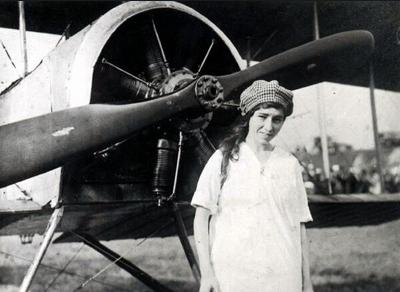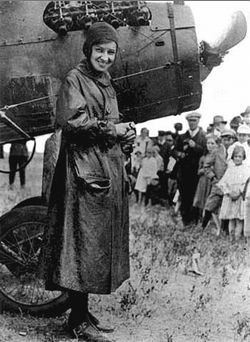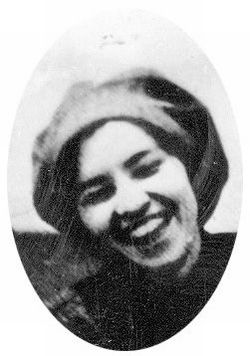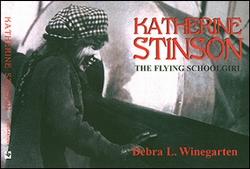Katherine Stinson Shapes Emerging Industry
In the early 1900s, flying was a novelty, pilots were idolized
like movie stars, and air shows drew huge crowds fascinated by the
emerging technology of flight.

Few men were brave enough to take to the sky and women pilots
were rare. That is what makes Katherine Stinson's aviation
accomplishments all the more significant. She helped shape the US
aviation program being highlighted this year during the Centennial
of Flight observance and is an integral part of the March
celebration of Women's History Month.
Doing The Unexpected
"Back in the '20s and earlier, there weren't that many women
fliers. Women weren't expected to do things that men accomplished,"
said Dorothy Lucas, who towed aerial targets for student gunners as
a member of the Women Airforce Service Pilots during World War
II.
Women did not begin to enter pilot training in the Air Force
until 1976, navigator training until 1977 and fighter pilot
training until 1993; however, skilled female pilots began flying
soon after the advent of flight, as early as 1910, according to
accounts.
Nine years after the Wright Brothers' first successful flight in
1903, there were less than 200 licensed pilots. Of those, three
were women.
"The woman who got closest to aerial combat was Katherine
Stinson, older sister of the noted airplane builder Eddie Stinson,"
wrote John Lienhard in his book "Inventing Modern."
"The Amelia Earhart Of WWI"
 Stinson, nicknamed the "Flying Schoolgirl," was
the Amelia Earhart of World War I, said retired Air Force Col. W.R.
Stewart, heritage officer for the Stinsons chapter of the Order of
Daedalians, a fraternal organization for military pilots.
Stinson, nicknamed the "Flying Schoolgirl," was
the Amelia Earhart of World War I, said retired Air Force Col. W.R.
Stewart, heritage officer for the Stinsons chapter of the Order of
Daedalians, a fraternal organization for military pilots.
"She was a little girl, with these huge eyes and big mass of
black hair," Stewart said. "She only flew for six years but was a
tremendous inspiration for girls all over the country."
Most women of that era did not drive cars, let alone fly
airplanes, a hazardous profession for even an experienced pilot.
Overcoming challenges of gaining parental permission, financing
training and convincing an instructor to take a woman on board was
difficult to overcome, said Stewart.
"Pretty brave of her in her day, quite remarkable really," Lucas
said. "Katherine and the other early female aviators were quite an
inspiration to women. They surely made a big difference."
Lucas said these women were thrilled with the idea of flying and
did not concern themselves with the danger. Flying was something
they loved to do and they showed they could do it.
"Katherine did so many things in her life, and she did them all
well, especially for a woman in those days and such a petite woman
at barely 5 feet high, 100 pounds," said John Tosh, director of the
Stinson Chapter of the Texas Air Museum. "She was turned down many
times by flying instructors who felt it took big muscles to fly a
plane."
Fast Talking, Fast Solo
 Despite the obstacles, Stinson convinced Max
Lillie, a famous aviation instructor, to teach her to fly. She flew
solo after only four hours of instruction.
Despite the obstacles, Stinson convinced Max
Lillie, a famous aviation instructor, to teach her to fly. She flew
solo after only four hours of instruction.
Katherine received her pilot license in July 1912 at age 21,
making her the fourth woman pilot in America.
At a time when women were secretaries, teachers or store clerks,
Stinson performed as an exhibition pilot, earning as much as $1,000
per appearance.
"When you fly upside down you don't feel as if you had turned
over. Rather, you feel as if the Earth had changed places with the
sky and was hanging over you," Stinson was reported to have said,
according to Debra Winegarten, author of "Katherine Stinson, The
Flying Schoolgirl."
Unstoppable
"She was unstoppable," said Winegarten. "When there was
something she set her mind to do, she did it. Period. When the men
refused to teach her how to loop-the-loop because she was a woman
and they thought her looping too dangerous, she just watched how
they did it and taught herself."
Among her accomplishments, she was the first woman to fly solo
at night, the first pilot to perform skywriting, the first woman to
fly for the U.S. Postal Service and, in December 1917, she set the
record for long distance flying. She later broke her record with a
783-mile flight from Chicago to New York.
Setting Records
As an internationally acclaimed stunt pilot, she set aviation
record after record, yet like several of her female pilot
colleagues, she was denied her right to fly for her country in
World War I.
"She and her sister were turned down several times by the War
Department, who told her it was a man's job," Tosh said.
According to Winegarten, when the Army refused to let Stinson
join the war effort, she contacted newspapers from New York to
Washington, proclaiming she would fly over their cities on a
certain day and asking people to come out when she flew past. As
she flew above the crowds, she "bombed" them with Red Cross pledge
forms. In one day in June 1917, she raised more than $2 million for
the Red Cross.
 Stinson's love of flying led to a family of
aviation pioneers. All four Stinson siblings, Katherine, Eddie,
Marjorie and Jack, received their pilot licenses and are in the
Texas Aviation Hall of Fame.
Stinson's love of flying led to a family of
aviation pioneers. All four Stinson siblings, Katherine, Eddie,
Marjorie and Jack, received their pilot licenses and are in the
Texas Aviation Hall of Fame.
In 1916, the family created the Stinson School of Flying at
Stinson Field in San Antonio. Stinson Field today is the second
oldest continuously running civilian airport in the United
States.
Although women pilots made significant contributions to
aviation, it was not until 1994 that 1st Lt. Jeannie Flynn became
the first woman to qualify as an Air Force fighter pilot, 75 years
after Stinson first volunteered to fly and fight for her
country.
"She inspired hundreds of thousands of potential aviators
worldwide. She showed the world it was possible for anyone with the
gumption and wherewithal to learn to fly to be able to do so,"
Winegarten said. (Courtesy of Air Education and Training Command
News Service)
 ANN's Daily Aero-Linx (04.16.24)
ANN's Daily Aero-Linx (04.16.24) Aero-News: Quote of the Day (04.16.24)
Aero-News: Quote of the Day (04.16.24) Airborne 04.10.24: SnF24!, A50 Heritage Reveal, HeliCycle!, Montaer MC-01
Airborne 04.10.24: SnF24!, A50 Heritage Reveal, HeliCycle!, Montaer MC-01 Airborne 04.12.24: SnF24!, G100UL Is Here, Holy Micro, Plane Tags
Airborne 04.12.24: SnF24!, G100UL Is Here, Holy Micro, Plane Tags Airborne-Flight Training 04.17.24: Feds Need Controllers, Spirit Delay, Redbird
Airborne-Flight Training 04.17.24: Feds Need Controllers, Spirit Delay, Redbird






